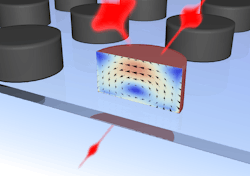All-Optical Switch Could Push Electronics Out of Future Processors
Over the last few years, the semiconductor industry has fallen behind the rapid pace of Moore’s Law, the theory that the number of transistors that can be etched onto an integrated circuit will double every two years. For chipmakers, it has become increasingly difficult to further shrink transistors—the building blocks of computer processors—while increasing switching speed and limiting electrical resistance.
However, computer processors might find additional bandwidth from an unexpected source: particles of light. Researchers from Moscow State University have invented an optical switch on a silicon nanostructure that could become part of a future generation of light-based transistors and logic gates. With additional research efforts underway, the technology might have the potential to compete with electronic transistors.
The main feature of the all-optical switch is that it uses photons—and not electricity—to operate at ultrafast switching speeds. All-optical devices can operate with extremely fast switching speeds and high energy efficiency because they exhibit lower heat loss, better signal-to-noise ratios and are less susceptible to interference. An optical computer attempts to imprint data onto light waves and process the information as it travels through silicon chips.
After a series of experiments, the research team developed an optical switch 250 nm in diameter and capable of switching optical pulses at femtosecond intervals (one millionth of one billionth of a second). Processors and data transmission devices with the same switching speed would have the ability to process and send information at tens and hundreds of terabits per second. The high switching speed was achieved by using the nonlinear optical effects when two or more high-intensity light signals are combined.
The discovery represents a major step forward in a field that has been beleaguered by a surplus of intriguing research and a dearth of practical advancements. For years, the study of photonics has been guided by the promise that particles of light have higher computational bandwidth than electrons and can support a greater number of instructions per second (IPS) when used in computer processors.
Maxim Shcherbakov, a scientist in the Laboratory of Nanophotonics and Metamaterials at Lomonosov Moscow State University, says that the research could lead to smaller and more efficient active photonics, including logic units and transistors. The switching speeds of the new photonics switch can be translated into silicon photonics, he says. The researchers have future plans to test the nanostructures in integrated circuits.
The critics of photon-based computing, however, have a more guarded view of the technology. Rodney S. Tucker, an electrical engineering professor at Melbourne University, writes in the journal Nature Photonics that logic systems require “logic-level restoration, cascadability, fan-out, and input-output isolation.” He maintains that electronic transistors currently provide all of these capabilities at low cost, low power, small size, and relatively high speed.
For optical logic to become competitive with electronics, nonlinear optical technology will have to overcome several problems related to power consumption, cost, and systems integration. It could require a fundamental change in the nature of computing itself, Tucker suggests. Computers with both optical and electronic components often struggle with high energy losses that slow down transmission speeds. But all-optical computers have the potential to eliminate these issues.
Another issue is that for years the typical size of photonic transistors has stalled on the scale of several micrometers, while the typical size of electronic transistors has advanced to 14 nm. This small size naturally feeds into the computer industry’s shift from personal computers to mobile devices that require smaller and more powerful processors.
At the same time, advances are still being made to open the door to smaller and smaller transistors. In October, IBM researchers at the company’s Thomas J. Watson Research Center found a way to further shrink transistors using parallel rows of carbon nanotubes. This new approach could make it possible to continue shrinking transistors without increasing electrical resistance.
The results of the optical experiments, which were published in the journal Nano Letters and highlighted in the journal Nature Materials, grew out of the discovery that silicon nanoparticles exhibit strong resonances—so-called magnetic dipole resonances—in the visible spectrum. This type of resonance is characterized by strong localization of light waves on sub-wavelength scales inside the nanoparticles.
The optical switch created by MSU researchers is based on the interaction between two femtosecond pulses and this interaction results from the magnetic resonance of the silicon nanostructures. If pulses arrive at the nanostructure simultaneously, one of them interacts with the other and dampens it due to the effect of two-photon absorption. If there is a 100-fs delay between the two pulses, the interaction does not occur; the second pulse then goes through the nanostructure without changing.
About the Author
James Morra
Senior Editor
James Morra is the senior editor for Electronic Design, covering the semiconductor industry and new technology trends, with a focus on power electronics and power management. He also reports on the business behind electrical engineering, including the electronics supply chain. He joined Electronic Design in 2015 and is based in Chicago, Illinois.

